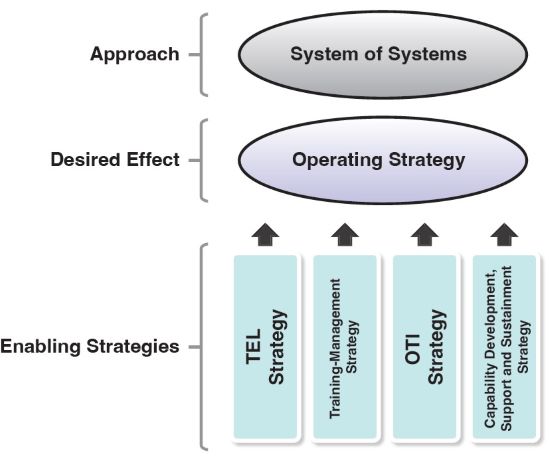Chapter 1: Introduction
This RCAF Training Modernization Strategy (TM Strategy) describes a coordinated approach to the development and support of a future technologically enabled, integrated Air Force training system (AFTS). For the purposes of this document, the term "future AFTS" (FAFTS) includes all aspects of training, education and professional development (PD). This TM Strategy is the keystone document by which future training capability-development plans should be informed. It is subordinate to the RCAF Strategy and CAF individual training and education (IT&E) modernization as well as aligned with the Royal Canadian Air Force Aerospace Warfare Centre's (RCAF AWC's) collective training (CT) modernization efforts. As such, the TM Strategy is broadly focused on the full spectrum of aerospace training as an integral part of the RCAF's force generation (FG) system and how this system will integrate within the greater CAF training system.
The TM Strategy describes, at the strategic level and for the benefit of RCAF stakeholders, how the AFTS will be modernized to accomplish its future FG mission and to enable the RCAF's training system to successfully transition to its future capabilities. The TM Strategy lays the foundation for evolving the RCAF's business of training to a modernized model based on optimized training methods, technologies, infrastructure, management, support and sustainment systems. An important element of this strategy is achieving reform while preserving critical elements of RCAF culture. Ultimately, the TM Strategy will enable the priority—excellence in operations— by efficiently generating highly competent individuals and teams.
(RCAF Strategy / RCAF Campaign Plan [CP] –
Value our people and invest in their future)
Strategic Vision
The FAFTS will be an integrated system of training aligned with force development (FD), FG and force employment (FE) systems. It will be based on sustainable, scalable and flexible system-design principles; rooted in our aviation heritage, ethos and leadership philosophy; and enabled by technology to produce world-class training, enhanced readiness and excellence in operations.
Strategy Overview
This system of training is intended to bring together all elements of the aerospace training spectrum and link them to other RCAF and CAF FD, FG and FE systems to provide the RCAF with an agile, coherent, sustainable, interoperable and well-supported means of generating aerospace forces.
The TM Strategy's approach is divided into five parts. These five parts are the following enabling strategies: operating strategy; TEL strategy; training-management strategy; operational training–infrastructure (OTI) strategy; and capability development, support and sustainment strategy. Together, they articulate how the FAFTS will generate highly interoperable forces capable of working within complex joint and coalition operating environments and focused on delivering operational excellence.

Figure 1. The TM Strategy’s approach, desired effect and enabling strategies Footnote 1
Caption
The TM Strategy describes, at the strategic level and for the benefit of RCAF stakeholders, how the Air Force Training System will be modernized to accomplish its future Force Generation mission and to enable the RCAF's training system to successfully transition to its future capabilities. Enabling strategies include Technology-Enabled Learning, Training-Management Strategy, Operational Training-Infrastructure Strategy and Capability Development Support and Sustainment Strategy. These contribute to the desired effect of a comprehensive Operating Strategy. The operating strategy itself becomes part of a system of systems within the Royal Canadian Air Force. Ultimately, the TM Strategy will enable the priority—excellence in operations— by efficiently generating highly competent individuals and teams.